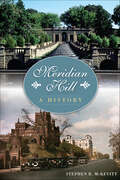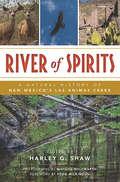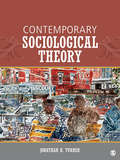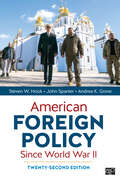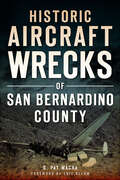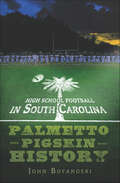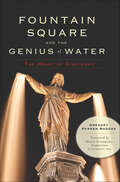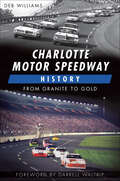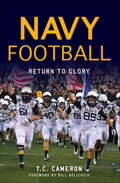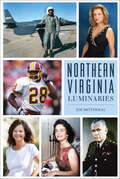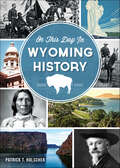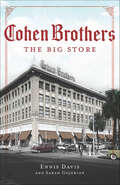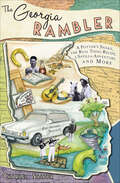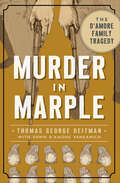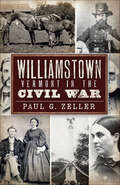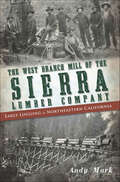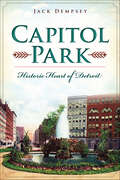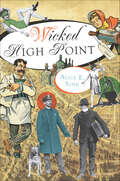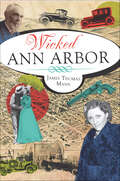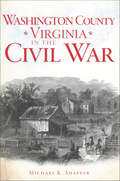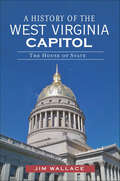- Table View
- List View
For the Love of Texas: Tell Me about the Colonists!
by George Christian Betsy ChristianBefore Texas was Texas, it was a lot of things to a lot of different people. Comanche, Choctaw, French, Spanish, Mexican and more laid claim to Texas soil as their own, and no one wanted to share. The fights and alliances that arose out of the colonization of Texas shaped the state's future. Find out all about the beginning of the state and the colonists who helped pave the way for the Texas we now know. Saddle up with Betsy and George Christian for an interactive, fun chapter in Texas history for kids that challenges them to ask questions about the history they're told and the world in which they live.
Meridian Hill: A History (Landmarks)
by Stephen R. McKevittIn the nineteenth century, Commodore David Porter built his mansion on a prominent hill sitting directly north of the White House, and the rest of Meridian Hill's history is indelibly tied to the fabric of Washington. John Quincy Adams once resided in Porter's mansion. Union troops used the estate and its lands during the Civil War. Later, part of the old estate was famously developed by Mary Henderson into a noted group of embassy mansions, and the extraordinary Meridian Hill Park was created. The rest of the land became a diverse, thriving residential neighborhood. Join local author Stephen McKevitt as he chronicles the fascinating story of this interesting urban locale in the nation's capital.
River of Spirits: A Natural History of New Mexico’s Las Animas Creek (Natural History)
by Matilde HolzwarthOriginating high in New Mexico's mysterious Black Range and flowing to the Rio Grande amid contorted, ghost-like sycamores, Las Animas Creek remains one of the least accessible landscapes in the nation. The watershed is best known as the site of Apache chief Victorio's last major battle with the U.S. Cavalry before his retreat and ultimate defeat by the Mexican army. Despite its geographic isolation, the watershed remains closely linked with the history of nearby Kingston, Hillsboro and Caballo. Once home to New Mexico's last grizzly, Las Animas sustains a diverse range of native plants and wild animals, including bison, prairie dogs and mountain lions, as well as a host of endangered species. Aldo Leopold Wilderness and Ted Turner's Ladder Ranch ensure it remains Rio de las Animas, the "River of Spirits." Wildlife research biologist Harley G. Shaw compiles a human and natural history of this remote ecosystem.
Contemporary Sociological Theory
by Jonathan H. TurnerWritten by award-winning scholar, Jonathan Turner, Contemporary Sociological Theory covers the range of diversity of theory in nine theoretical traditions, and variants of theoretical approaches in these traditions. The result is a comprehensive review of present-day theorizing in sociology covering functional, evolutionary, ecological, conflict, interactionist, exchange, structuralist, cultural, and critical theories and the major proponents of these theories. Moreover, for each theoretical tradition, it origins are examined in a separate chapter with an eye to how classical theorists influenced the work of key contemporary scholars. This book will serve as a valuable resource for those readers seeking in-depth and comprehensive coverage of contemporary traditions in their historical contexts. Unlike many texts, coverage is comprehensive and deep. The theories and their origins are examined in detail so that readers can fully understand the origins and present profile of theories in present-day sociology. Unlike many texts that skim over theories on the surface, this book seeks to unlock for the reader their underlying structure of each theory. The book is written in a modular format so that theories and traditions can be examined in any order, and in many diverse combinations. If desired, only the contemporary theories can be read without attention to their historical contexts, or the reverse is true if readers want to understand the historical origins of a particular theoretical tradition. Since Jonathan Turner is an active theorist in his own right, he brings to the book an appreciation of how theories are created as an insider rather than as only a commentator on theory. As such, he is able to bring out the underlying assumptions, structure, and form of a theory in new and interesting ways for casual readers and scholars alike.
American Foreign Policy Since World War II
by Steven W. Hook John W. Spanier Andrea K. GroveNow in its Twenty-Second Edition, Hook, Spanier, and Grove’s American Foreign Policy Since World War II has long set the standard in guiding students through the complexities of American foreign policy. The text introduces students to the American "style" of foreign policy, imbued with a distinct sense of national exceptionalism. By giving students the historical context they need, this book allows them to truly grasp the functions and dysfunctions of the nation’s foreign policy agenda with historical insight into modern policy context.
American Foreign Policy Since World War II
by Steven W. Hook John W. Spanier Andrea K. GroveNow in its Twenty-Second Edition, Hook, Spanier, and Grove’s American Foreign Policy Since World War II has long set the standard in guiding students through the complexities of American foreign policy. The text introduces students to the American "style" of foreign policy, imbued with a distinct sense of national exceptionalism. By giving students the historical context they need, this book allows them to truly grasp the functions and dysfunctions of the nation’s foreign policy agenda with historical insight into modern policy context.
Historic Aircraft Wrecks of San Bernardino County (Disaster)
by G. Pat MachaWeather, darkness and twists of fate have contributed to more than three hundred airplane crashes in San Bernardino County, California. Many of these accidents occurred in the vast Mojave Desert, others on the cloud-shrouded, snow-capped mountains of the largest county in the lower forty-eight states. Searches often were labored yet fruitless, even for the privileged: Frank Sinatra's mother perished here in a downed plane. The quest for an aircraft containing $5,000 in cash has become the stuff of legend. Tales of survival in uninhabited, rugged landscapes have been especially harrowing. Join renowned aircraft-crash search specialist G. Pat Macha for dozens of sorrowful, triumphant, touching and surprising true stories of those who lived through the ordeals of plane crashes--and others who didn't.
High School Football in South Carolina: Palmetto Pigskin History (Sports)
by John BoyanoskiSouth Carolina has a proud tradition of high school football stretching back to the 1890s, making the sport one of the most celebrated in the state. Discover how Florence High School-- sometimes dubbed the Yellow Jackets or the Golden Tornados--won the first four state titles, a record that has been tied but never broken. And learn about the aftermath of a 1922 game between Columbia and Charleston, when violent Columbia fans hurled eggs at the Charleston train as the players left for home. Through the 1960s, the sport withstood the immense pressure of integration until 157 teams ballooned into 193 by the end of the decade. John Boyanoski reveals the trophies, tears, and triumphs of the Palmetto State's time-honored football legacy.
Fountain Square and the Genius of Water: The Heart of Cincinnati (Landmarks)
by Gregory Parker RogersIn 1871, Henry Probasco donated the Tyler Davidson Fountain to the people of the city of Cincinnati in honor of his brother-in-law. Probasco wanted to leave a practical and artistic gift to the city and its residents that had made both men fabulously wealthy. Though it was placed on Fifth Street, away from the central business district, the fountain became a centerpiece of the city around its boom years, and downtown Cincinnati grew up around the statue. Author Greg Rogers chronicles the history of the fountain and its influence on the landscape and culture of the city.
Charlotte Motor Speedway History: From Granite to Gold (Sports)
by Deb WilliamsEngines roared at Charlotte Motor Speedway for the first time in 1960, and the track has been home to some of NASCAR's greatest races and most honored drivers ever since. Despite early challenges, Bruton Smith and Humpy Wheeler took charge in 1975, and together sculpted one of the most famous race tracks in America as host of the Coca-Cola 600 and the Sprint All-Star Race. In 1992, the track became the first modern speedway to host night racing and thousands of race fans watched their favorite drivers swap paint under the North Carolina night sky. Get in the groove with racing journalist Deb Williams as she traces the history of the Charlotte Motor Speedway, with plenty of pit-stops along the way.
Medfield's Dwight-Derby House: A Story of Love & Persistence (Landmarks)
by Electa Kane TritschConstructed in 1651, the Dwight-Derby House stands as the centerpiece of the Medfield town common and at the heart of the town�s history. Contained within the walls of this 350-year-old time capsule are the stories of two prominent families: the Dwights and the Derbys�united in their deep connection to the home. To this day, the house remains a testament to the dedication and fortitude of the community, which banded together and succeeded in preserving this historic landmark. Join Electa Tritsch on her journey of sifting through records, artifacts and dusty cardboard boxes as she enlivens the story of the Dwight-Derby House�a home that has brought outthe best of this thriving community.
Navy Football: Return to Glory (Sports)
by T. C. CameronNavy football holds a unique place in college athletics as one of the oldest and most prestigious programs the game has ever known. During the 1950s and 1960s, the Midshipmen were nationally recognized by the major bowl games they played and Heisman Trophy-winning players Joe Bellino and Roger Staubach. Although the program struggled mightily to maintain relevancy in subsequent years, Athletic Director Chet Gladchuk kick-started the renaissance of Navy football by hiring Coach Paul Johnson in 2001. The team's current coach, Ken Niumatalolo, once fired by the academy in the dining room of a McDonald's in 1998, returned to become the winningest coach in school history. Author T.C. Cameron charts the story of Navy football and steers readers through the reemergence of an iconic program representing our nation's finest.
Northern Virginia Luminaries (American Chronicles)
by Joe MotheralJournalist Joe Motheral tells the stories of prominent locals met and interviewed over the course of his long career. People from all over the US and the world move to northern Virginia to be close to the nation's capital, and many people of national importance make their home in the area. There are as many more, born and raised here, who are well known to locals. Become acquainted with a selection of iconic Virginians, with varying personalities and a variety of fulfilling lives. Read about Geraldine Brooks, Roger Mudd and General George C. Marshall, as well as local heroes.
On This Day in Wyoming History
by Patrick T. HolscherWyoming might be known as the least populous state, but this land of mountains and prairies is home to enough history to provide an entertaining footnote for each day of the year. On September 6, 1870, Wyoming was the first state to give women the right to vote, and on March 1, 1872, Yellowstone became the world's first National Park. JCPenney opened its doors in Kemmerer on April 14, 1902, while May 1, 1883, marks Buffalo Bill Cody's very first Wild West Show. Join Pat Holscher on a day-by-day look at some of the Equality State's most fascinating factoids.
Cohen Brothers: The Big Store
by Ennis Davis Sarah GojekianOnce known as the "Wanamaker of the South," Cohen Brothers department store captured the hearts of thousands of Jacksonville residents. Metro Jacksonville writers Ennis Davis and Sarah Gojekian take a wonderful trip through the store, from its beginnings as a dry goods enterprise in a small log cabin to its growth into a trend-setting retail institution and the final poignant closing of its doors. Davis and Gojekian brilliantly combine interviews with former employees, stories from the vibrant atmosphere the store created and memories from longtime residents to bring readers back to the bright glow and elegance of one of the South's most distinctive enterprises.
The Georgia Rambler: A Potter's Snake, the Real Thing Recipe, a Satilla Adventure and More
by Charles SalterFor years, veteran Atlanta Journal-Constitution columnist Charles Salter roamed the state in his 1975 Chevy station wagon in search of the most offbeat characters to appear in his celebrated column, "The Georgia Rambler." From tall tales of the Okefenokee Swamp, to treasure hunters of Duluth and ex-moonshiners of North Georgia, Salter's stories are as eclectic and extraordinary as the people he interviewed. Along the way, he discovered the alleged original recipe for Coca-Cola in the pages of an old pharmacist's book, a find that inspired an episode of award-winning radio show This American Life. Read these remarkable stories and more in this never-before-published compilation of the best of "The Georgia Rambler."
Murder in Marple: The D’Amore Family Tragedy (True Crime)
by Thomas George DeitmanBenjamin D'Amore abused his wife for the last time on November 29, 1949. That night, his sons John and Nicholas exacted revenge and executed Benjamin with a shotgun and deer rifle. The trial that followed was unlike many before it. Two psychiatrists diagnosed the brothers with "catathymic crisis," which inhibited their judgment during the crime. But despite the defendants' guilty plea, an all-female jury acquitted them. Thomas Deitman and Dawn D'Amore Yankanich unravel the horrific events and conspiracies regarding the shocking patricide case.
Williamstown, Vermont, in the Civil War (Civil War Series)
by Paul G. ZellerThough it was far from the front lines of the War Between the States, Williamstown, Vermont, made undeniable contributions to the victory of the United States Army. The proud sons of Patriots fell on the fields of Gettysburg, Antietam and Shiloh, and many gallant soldiers were lost in lesser-known skirmishes. These men fought for honor, for country and at times for money. Many men made the ultimate sacrifice, and others who returned home bore the scars of battle for the rest of their lives. With the support of the Williamstown Historical Society, author Paul Zeller honors the Williamstown soldiers and ordinary citizens who fought to preserve the Union and presents their incredible stories of adventure and bravery.
The West Branch Mill of the Sierra Lumber Company: Early Logging in Northeastern California
by Andy MarkIn the late 1800s, the green gold of California's inland timber belt included the long-coned sugar pine and cinnamon-dusted ponderosa pine of Big Chico Creek Canyon. Tucked into the steep terrain of present-day Butte and Tehama Counties, the bustling West Branch Mill logging operations moved timber from the foothills east of Chico to waiting markets in Sacramento, Marysville and San Francisco. Local author Andy Mark recounts the lesser-known history of the West Branch Mill, recalling a time when resident physician Newton T. Enloe treated the daring men who faced daily peril, John Bidwell's bumpy and sometimes treacherous Humboldt Wagon Road was essentially the only route to town and Big Chico Creek was lined with an elevated flume running lumber and ambulance rafts.
Capitol Park: Historic Heart of Detroit (Landmarks)
by Jack DempseyCapitol Park is the only city park in America where a state's first governor is buried. It's the birthplace of democracy in Michigan. Underground Railroad site. Streetcar and transit hub. Urban canyon. A block north of Detroit's iconic Coney Island restaurants. A symbol of the city's late twentieth-century decay, now a key part of its revitalization in a new millennium. Jack Dempsey, award-winning author of "Michigan and the Civil War" and president of the Michigan Historical Commission, uncovers tales of a uniquely inspirational public space that epitomizes the ups and downs of Detroit's three centuries.
Wicked High Point (Wicked)
by Alice E. SinkHigh Point, nestled in the heart of the Piedmont Triad, has long been at the forefront of progress, attracting those entrepreneurs who were "up to something out of the ordinary"?, a place where spanking leads to tragedy, ransom notes are left in mailboxes and people are railroaded through court. When Prohibition swept the nation, High Point's first saloonist stayed in business for only eighteen hours. High Point's speed-demon racecar drivers opted to smuggle liquor in their uncatchable cars, which sparked the beginning of NASCAR. Join veteran author Alice Sink as she explores these and other tales, from the cruel and comical to the mischievous and outrageous, in the story of this "international city's"? colorful past.
Wicked Ann Arbor (Wicked)
by James Thomas MannAnn Arbor is known as a center of culture and education, but that hasn't prevented various tyrants and scoundrels from sullying the sophistication with base and murderous deeds. Revisit the case of "Jacke the Hugger," a turn-of-the-century deviant who routinely accosted and squeezed the women of Ann Arbor. In an effort to lure him from hiding, young men dressed as women and walked city streets. In 1903, UM student Albert Patterson disappeared in what was compared to a dime novel manner. Was he kidnapped by the Mexican Mafia? Carried off in a flying machine? Or did he flee because he was promised to marry two women at the same time? The first panty raid is said to have been carried out at the University of Michigan in March of 1952, starting the fad of the 1950's. It even made the cover of Life magazine. This is only a hint of the wickedness to be found in the history of Ann Arbor.
Montgomery's Civil Heritage Trail: A History & Guide (Landmarks)
by Site Directors Friends of the Civil Heritage TrailMontgomery's cultural heritage reflects two of America's most transformative struggles: the Civil War and the civil rights movement. On February 18, 1861, Jefferson Davis was inaugurated as president of the Confederate States of America on the Alabama Capitol steps. Those same steps marked the final destination of the Selma-Montgomery voting rights march on March 25, 1965. The telegram to fire on Fort Sumter originated from the Winter Building on Court Square on April 11, 1861. Just down the street, and a century later, Mrs. Rosa L. Parks refused to give up her seat, sparking the Montgomery Bus Boycott. Discover these compelling stories and more surrounding the historical landmarks along Montgomery's Civil Heritage Trail.
Washington County, Virginia, in the Civil War (Civil War Series)
by Michael K. ShafferThe citizens of Washington County, Virginia gave up their sons and daughters to the Confederate cause of the Civil War. Contributing six Confederate generals as well as Union officers, the region is emblematic of communities throughout the nation that sacrificed during the war. Though the sounds of cannon fire and gunshots were only heard at a distance, Washington County was the breadbasket for Confederate armies. From the fields surrounding Abingdon to the coveted salt works in Saltville, Union Generals were constantly eyeing the region, resulting in the Saltville Massacre and the burning of Abingdon's famous courthouse. Historian Michael Shaffer gives a detailed narrative of Washington County during the Civil War, painting vivid images of heroism on and off the battlefield.
A History of the West Virginia Capitol: The House of State (Landmarks)
by Jim WallaceEven though the West Virginia Capitol deviated from the design of legendary architect Cass Gilbert, the iconic building is still considered a masterpiece. The full story of the Capitol is filled with twists and turns, from the fortunate fire that burned its predecessor to the tug of war between Wheeling and Charleston for the designation of state capital. Revisit the to-gild-or-not-to-gild debate that raged around the construction of the Capitol's signature crown, which once was in danger of collapsing on itself or toppling in heavy winds. Join Charleston author Jim Wallace for this captivating account of West Virginia's architectural jewel.

